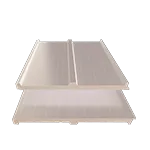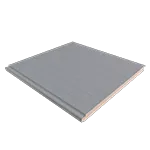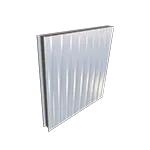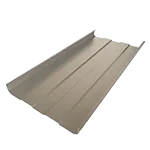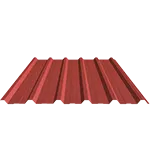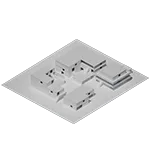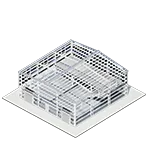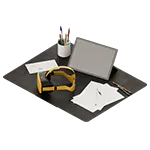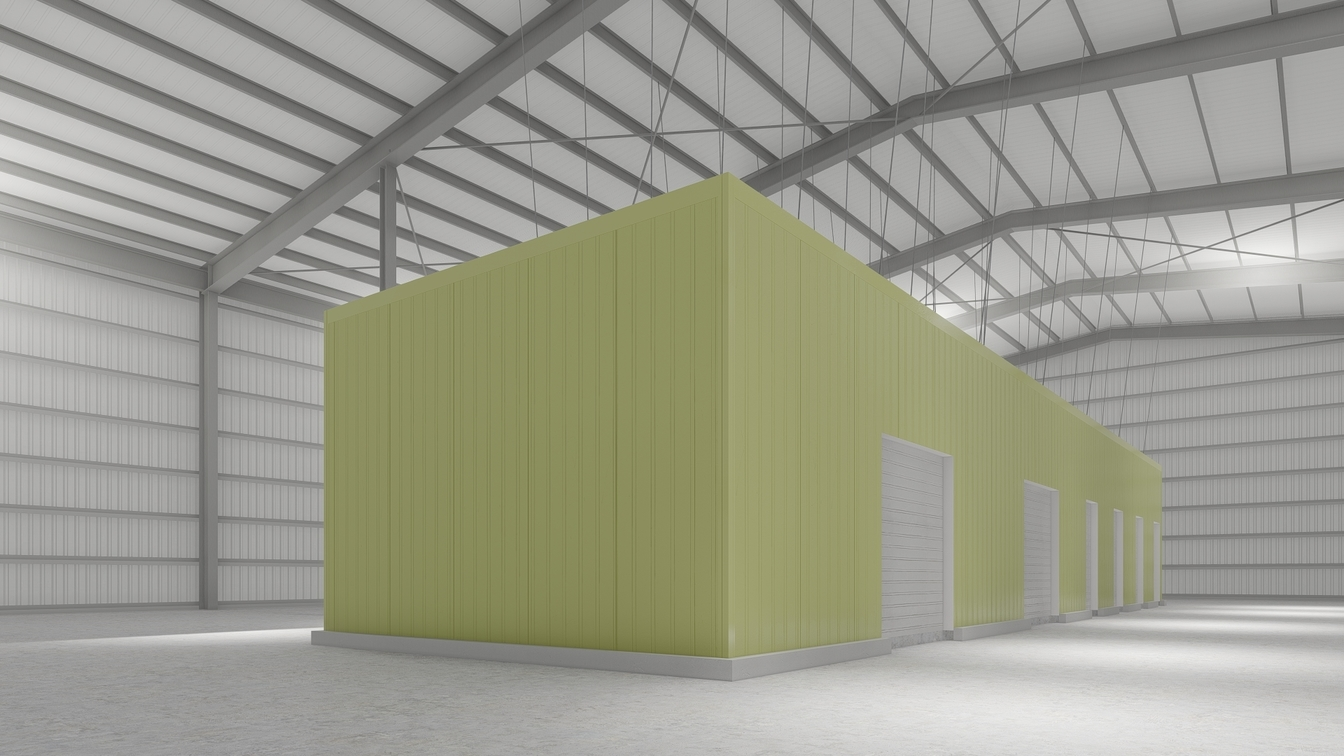Insulated panels for cold rooms? Fire resistance of cold rooms? These are some of the questions we are going to answer in the following article. We’ll review what a cold room is, what elements they are composed of, what we should know before building a cold room. We focus on the use of the refrigeration sandwich panels as the enclosure element of cold rooms, not without mentioning the other components that are part of them and that are relevant at the time of building.
Quality, certifications, and special attention among the different systems of insulated cold storage panels, are some of the factors to be considered from the very beginning if we want our cold room installations to be durable, useful, and insurable.
What is a cold room?
The truth is that we could find multiple definitions about what is a cold room or refrigerated chamber, so the first thing we will clarify is that we will talk about cold rooms in the industrial sector.
The cold room or refrigerated chamber is a space designed to maintain a specific controlled temperature through the use of refrigeration equipment. This temperature is usually below the temperature range on the outside.
Usually, this type of cold rooms or refrigerated chambers are used for processing or for the preservation of products during the manufacturing process. This can be in food handling, chemical processing, laboratory, or industrial manufacturing industries.
Considerations for designing and building a cold room
Therefore, it is important to note that when we think about the design and construction of cold rooms, we must take some aspects into account:
- Dimensions of the space, not only in surface, but also in height. The later is important because it will be necessary for the air-conditioning equipment to be installed.
- To know the working temperature inside the cold rooms. In the design of the cold rooms we must take into account the difference between the desired inside temperature and the temperature outside. For this it will be necessary to know the minimum and maximum range of outside temperature in the location of our cold room, as well as the desired interior temperature.
- To know the internal processes inside the cold room, as well as the processing or handling equipment to be carried out. Knowing these conditions will allow us to make a better calculation of the design of the cold room.
What are the elements that comprise a cold room?
- The enclosure: Depending on the working conditions required for each case, as well as the temperature differences between inside and outside, it will be necessary to calculate the insulation of walls, ceilings and in some cases even the floor of the cold room.
- Access doors: Often in the design of these spaces people forget the importance of this element. The characteristics of this element are key to the performance not only of the refrigeration equipment, but also to avoid temperature losses due to constant handling. An access door that keeps the chamber at the required temperature should not be an element to think about the most economical.
- Climate control equipment: It is the machinery that will allow us to maintain the constant temperature we need inside the refrigeration chamber.
In this blog post we focus on the enclosure of the chamber, because the access doors and air conditioning equipment are enough topics for another whole article on each of them.
Enclosure material: insulated cold storage panels
The most efficient way to build the envelope is to use sandwich insulation panels specially designed for this purpose. It is necessary to clarify that there are different types and qualities of insulated cold storage panels and not all of them will be useful if we want a cold room with quality and durability guarantees.
A insulated cold storage panel consists of two external metal sheets bonded to a core which serves as an insulating element. The metal sheets are usually made of steel with a finish on the outer faces.
The quality of the insulated cold storage panel
We usually find different manufacturers in the market, and therefore different qualities and technologies of sandwich panel fabrication. Everything has a purpose and is focused on a specific target market.
Let’s understand each of the elements, so that we can comprehend and search for what is best suited to each project and, at the same time, allow us to compare “pears with pears”, i.e., similar product ranges.
Product quality is defined on the basis of the product’s resistance to fire. It may seem contradictory that we value insulated cold storage panels for its fire resistance, but this is due to the fact that insurance companies take this parameter into account because these are industrial facilities that are exposed to high-risk situations. In other words, a cold room installation that is not built with fireproof materials may not be subject to an insurance policy that covers damages in case of loss.
We have already stated that the insulated cold storage panels, like the insulated panel for roof and walls, consists of two steel sheets and an insulating core. The similarities end there. The cold storage panels have a number of characteristics that differentiate it from other insulation materials and make it an element specially designed to optimize the reduction of thermal transmission between the inside and the outside of the cold room.
Thickness of insulated cold storage panels
Refrigerated panel core thicknesses are typically 3-1/8″, 4″ and 4-3/4″. However, it can be much thicker if the project requires it.
The choice of panel thickness is an optimization between the cost of the panel investment (the thicker the panel, the higher the price) and the reduction of the power and consumption of the cooling equipment for the cold room. Let’s explain it very simply: the thicker the sandwich panel, the lower the power capacity and consumption of the cold room air conditioning equipment.
In case of using a panel of lesser thickness, it will be necessary a greater capacity in the power and consumption of the air conditioning equipment.
A good design for a cold room is where the ideal point is found between the selection of the panel thickness and the power-consumption of the cooling equipment.
The insulated panel coating
If the cold room project is intended for use where a high level of sanitization is required, there are special paint coatings and finishes that are applied to the inside face of the panel to facilitate cleaning and prevent the accumulation or emergence of bacteria or contamination elements.
Among these coatings are PET and PVC 120 um. Both seek to prevent the generation of microorganisms in the case of storage and processing of food, as well as raw materials and products of the biological and chemical industries.
Insulating Core
Entry-level core
The core of the most economical insulating panel usually uses materials such as expanded polystyrene (EPS) and extruded polystyrene (XPS). This type of core has very good thermal transmission resistance performance but has a very important limitation: its chemical composition makes this type of core highly vulnerable when exposed to flames.
This is a type of core that is increasingly out of use, as many companies are turning away from this type of core due to its low resistance to accidents involving flames or fires.
If this type of insulated panel is used for your cold room, you should know that it will be practically impossible to obtain an accident insurance policy for the facilities or, in case of obtaining it, the cost will be significantly high.
Mid-range core and FM Approval system
In the medium range we find cores made of polyurethane foam, better known as PUR. It is necessary to clarify that within the PUR range we can find different categories, so it is necessary to request the product data sheet and manufacturer’s certifications in order to know in detail the quality of the foam core.
The difference between PUR cores is the performance it provides when exposed to a fire situation. The fact that it produces less smoke or that it keeps the product from degrading for a longer period of time are indicators of better quality.
How can I tell if one PUR is better performing than another? By comparing fire test performance values. Be wary of manufacturers who cannot provide a certification validated by an external approved body on the quality of the product.
Furthermore, there are polyisocyanurate (PIR) core foams, a compound with superior fire performance than PUR and which, depending on the manufacturer, can be certified with FM Approval, an internationally recognized certification that insurance companies rely on as an ideal construction system for the manufacture of cold rooms.
It is important to clarify that the FM Approval is not a certificate that is issued to the PIR insulating panel, but the installation process as a whole, which includes fastening elements, the panel itself, finishing elements, among other elements.
Therefore, if you use PIR insulated cold storage panels with FM Approval certificate to build a cold room, but you do not address the rest of the requirements during its assembly to be certified as a construction process under FM Approval standards, you will not obtain such certification.
Upper range core
In the highest range we find rock wool cores, which have the best performance in fire risk situations. Most developed countries have banned the use of EPS, XPS and even PUR panels for the construction of cold rooms, only allowing the construction with PIR cold room panels with FM Approval certification or rock wool core.
Among the rock wool cores we can find low density rock wool cores, up to high density rock wool cores. From lower to higher quality, it will provide us with better fire resistance performance, being able to obtain certifications that guarantee fire resistance of 60, 120 and 240 minutes, according to the type and thickness.
For a more detailed explanation of the fire resistance certification, please see our article Insulating Panels and Fire
Fastening system
Each refrigeration panels manufacturer has its own fastening system or joint between panels. It is necessary to corroborate the fastening system that best guarantees the watertightness and impermeability between panels. This will depend on the temperature conservation in the interior.
In most cases the tongue and groove shape between panels can indicate a good connection between them. But if an additional safety feature is required, there are refrigeration panels on the market with a mechanically tightened connection. These are known as “hook” connections.
The “hook” connection is a mechanical connecting mechanism between panels that guarantees maximum precision and tightness between the panels. It is a fixation that is achieved by the operation of a hook with manual adjustment during assembly.
PIR foam underlayment with Kraft-type paper covering
In cold rooms with significant temperature differences inside and outside, it is advisable to use polyisocyanurate (PIR) foam boards inside the floor, in order to avoid the loss of low temperature conservation through it. These PIR foam boards are usually placed on the entire cold store floor in order to ensure thermal insulation. They are usually placed under a layer of reinforced concrete, which forms the cold room floor.
The Ceiling of the Cold Room
To build the roof of the cold rooms, the same cold wall panels are used, but they are fastened using cable anchoring systems, which allow them to be fastened to the main structure of the building inside which the cold room is located.
Wrapping Up
It is important to know what are the characteristics, use and certification that we require for our cold room in order to be able to choose the insulated panels with the type of core that best suits.
Cold rooms, depending on the working conditions inside, and the temperature difference with the outside, may require thermal insulation in walls, ceilings and in some cases in the floor. For all this, there are appropriate systems and products that guarantee their good performance.
A good design of cold rooms is the one in which we find the appropriate combination between the thickness of the insulated panels and the cooling equipment that optimizes power consumption. This work is usually performed by a specialized technician considering the conditions, location, and use of each installation.
If you need to pay for an insurance policy for the cold room, we should consider from the beginning to use FM Approval certified panels or panels with rock wool core. It is crucial to contact an insurance company or broker to determine the criteria they evaluate to grant the policy.
Please note that this article is intended to provide general guidelines on building cold rooms and is not intended as a tool or advisory to meet specific insurance policy requirements.
